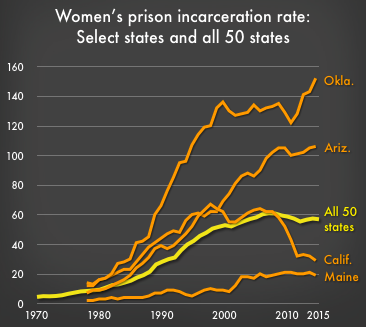Released on the heels of our recent report on women's state prison populations, a new BJS report shows that in 2016, the "gender divide" in incarceration trends widened even more.
by Wendy Sawyer,
January 10, 2018
Today, the Bureau of Justice Statistics released its annual update on prison populations in the U.S. Of course, it’s just my luck that they released the 2016 data the day after my report on women’s state prison population trends over time. But the changes over the last year are largely consistent with my finding that women’s prison populations remain near record highs while men’s populations are falling.
In 2016, state prisons across the U.S. cut men’s populations by more than 12,000 – but maddeningly, incarcerated over 700 more women than they did in 2015, widening the “gender divide” we’ve seen in the past few years. In 14 states, women’s populations grew or were unchanged while men’s declined. In some of these, the differences are minimal, but in others, the disparities are cause for alarm. The changes in these states underscore how the growth of women’s incarceration can undermine efforts to decarcerate:
- Tennessee managed to grow its overall prison population solely by incarcerating more women. The men’s population actually decreased, but that progress was thwarted by an even greater growth in the women’s population.
- South Carolina saw a modest reduction in the men’s prison population, but locked up 10% more women – enough to cancel out most of the reduction in the men’s population.
- Ohio reduced its prison population by 222 men – but counteracted most of that change by incarcerating 164 more women.
- In Arizona, almost half of the prison beds emptied by reductions in the men’s population were backfilled by additions to the women’s population.
The new report offers more evidence that as states undertake the critical work of reducing prison populations, they need to pay attention to these gendered trends. The most effective reforms will reverse the growth of all incarcerated populations, without leaving women behind.
Women’s prison populations are largely growing faster than men’s. See our 50-state analysis.
January 9, 2018
Easthampton, Mass. – States have made impressive progress over the last 10 years in reducing their prison populations, but for most women in prison, this progress might as well never have happened. Even as men’s incarceration rates are falling, women’s incarceration rates hover near record highs, a trend driven by criminal justice decisions at the state level. A new report from the Prison Policy Initiative identifies more than 30 states driving this national “gender divide.”

The mass incarceration of women has severe and far-reaching effects: 62% of women, for instance, are separated from minor children when they are put behind bars. But though this is largely an issue of state policy, “few people know what’s happening in their own states,” says Wendy Sawyer, author of The Gender Divide: Tracking Women’s State Prison Growth. Sawyer says states undermine their commitment to decarceration when their criminal justice reforms leave women behind.
For example:
- Texas recently reduced its men’s prison population by 6,000, while backfilling its prisons with 1,100 more women.
- Michigan’s female prison population grew 30% from 2009 to 2015, while the number of men in Michigan prisons fell by 8%.
- Six other states have seen men’s prison populations decline even as women’s populations have climbed.
The report features more than 100 state-specific graphs tracking 40 years of women’s prison growth, designed to help policymakers assess the need for local reform. It also isolates the underlying causes of women’s mass incarceration, including the War on Drugs, harsh sentencing for violent offenses, and the growing frequency of women serving jail time.
Women in prison are uniquely burdened by mental health problems and trauma, and Sawyer notes that most prisons, having been designed for men, “make those problems worse.” But she stresses that the appropriate response “is not to build better prisons – it’s to ensure women are included in reforms that move people away from prisons.” Most women in the justice system could be better served through alternatives to incarceration. Developing those solutions should be an urgent priority in every state.
How are women faring in your state? See the report and state-specific graphs https://www.prisonpolicy.org/reports/women_overtime.html.




